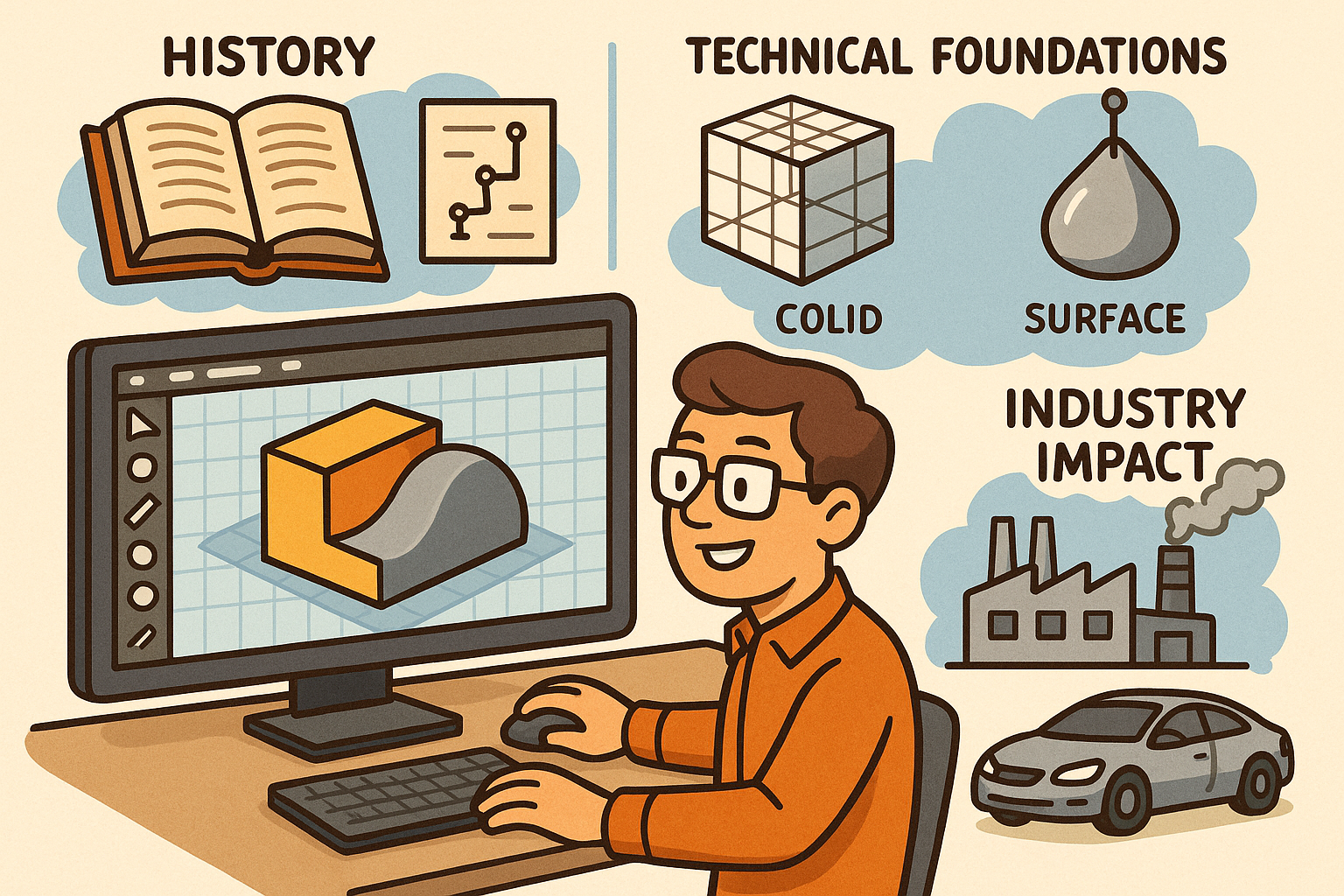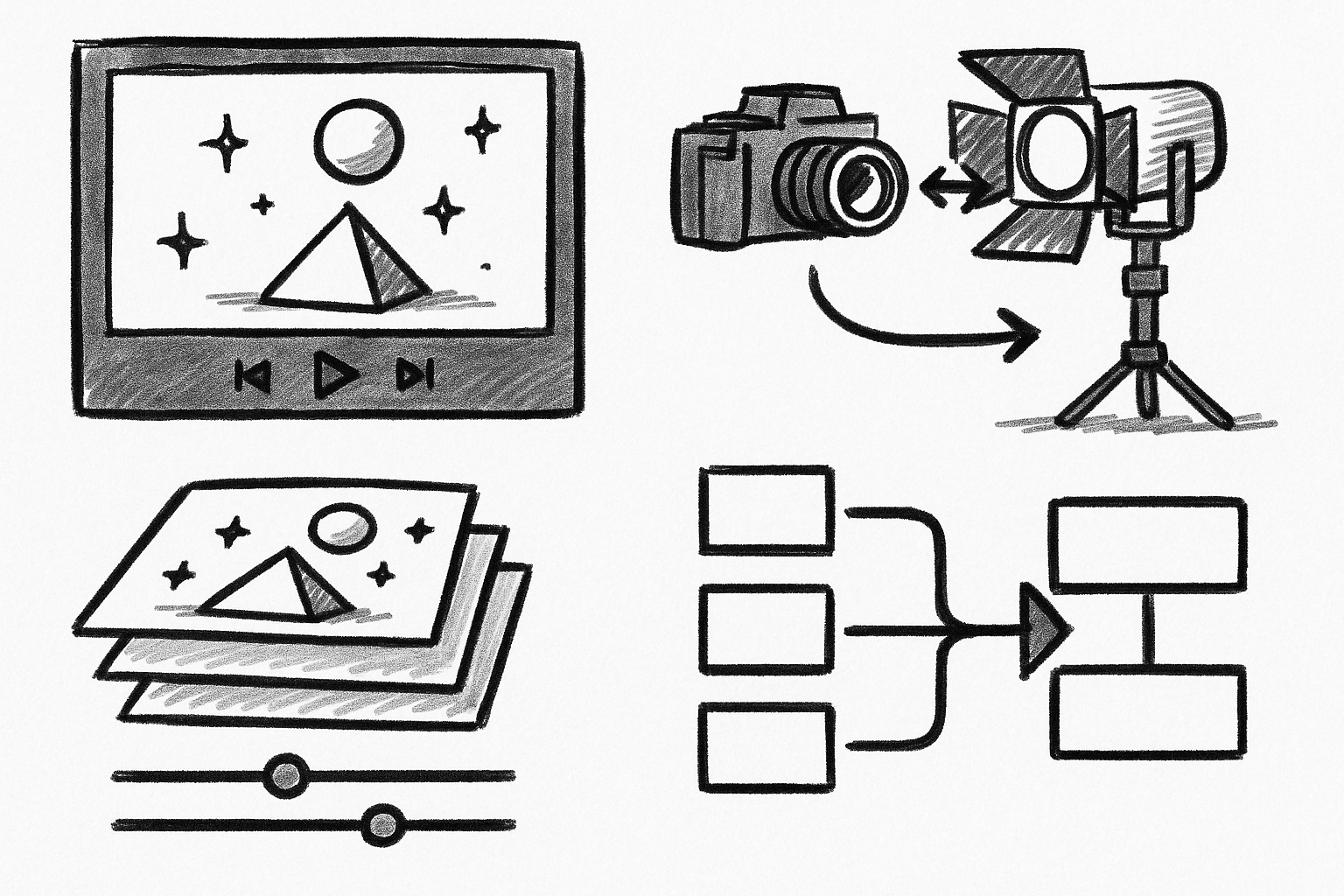Your Cart is Empty
Customer Testimonials
-
"Great customer service. The folks at Novedge were super helpful in navigating a somewhat complicated order including software upgrades and serial numbers in various stages of inactivity. They were friendly and helpful throughout the process.."
Ruben Ruckmark
"Quick & very helpful. We have been using Novedge for years and are very happy with their quick service when we need to make a purchase and excellent support resolving any issues."
Will Woodson
"Scott is the best. He reminds me about subscriptions dates, guides me in the correct direction for updates. He always responds promptly to me. He is literally the reason I continue to work with Novedge and will do so in the future."
Edward Mchugh
"Calvin Lok is “the man”. After my purchase of Sketchup 2021, he called me and provided step-by-step instructions to ease me through difficulties I was having with the setup of my new software."
Mike Borzage
Design Software History: Hybrid Modeling in Design Software: History, Technical Foundations, and Industry Impact
October 26, 2025 14 min read


Historical roots and motivations
Why hybrid modeling emerged
Hybrid modeling emerged because no single geometric representation could satisfy the full breadth of needs spanning precise engineering, organic design, simulation, and fabrication. Classic boundary representation (B-rep) and NURBS-based systems encode exact surfaces and support dimension-driven updates, but they struggle with topology changes and heavy sculptural edits. Polygonal meshes, in contrast, are light, easy to manipulate and subdivide, and perfect for digital art direction, yet they lack built-in guarantees about watertightness or curvature continuity and can be brittle for manufacturing. Meanwhile, implicit or volumetric fields support robust boolean combinations and natural topology change but traditionally lacked the analytic precision and associativity that mechanical CAD depends on. The result was a pragmatic, industry-wide realization: workflows must fluidly move between these representations, not pick a single winner.
The inevitability of this synthesis is visible in everyday demands. A designer may start with an ergonomic sculpt in a mesh-based tool, convert it into an implicit volume to hollow and lattice for weight reduction, then promote the outer shell to NURBS surfaces for dimensioning and tolerance control. In this path, each step shines because the representation matches the task. By letting B-rep, mesh, and volumetric paradigms coexist, teams reduce failure modes, accelerate iteration, and retain fidelity across visualization, simulation, and production. Put simply, hybrid modeling is less an ideology than a convergence born of necessity: parametric precision, mesh flexibility, and volumetric robustness each solve different problems, and modern pipelines must blend them without losing intent or integrity.
Practical drivers for convergence
Pragmatic drivers pushed hybrid modeling from theory into daily practice. Affordable 3D scanners and photogrammetry made reality capture common, and point clouds do not drop into a B-rep boundary cleanly; they require volumetric consolidation and mesh-based surface extraction before any parametric re-featuring is viable. Entertainment production ballooned the demand for organic form-making and rapid stylization, leading artists to sculpt high-resolution meshes and expect near-instant remeshing and voxel-like consolidation for stability. Then additive manufacturing mainstreamed the requirement for watertight volumetric models and repeated boolean operations to generate lattice infills, conformal cooling channels, and variable-density reinforcement. Each of these tasks sits naturally in a volumetric or implicit space first, and then it bridges into CAD for tolerance and documentation.
Equally important was the desire to combine engineering-grade analysis with freeform exploration. Industrial designers wanted to blend ergonomic, anthropomorphic geometry with tight GD&T-controlled features; architects wanted to iterate on performative facades while retaining precise panelization; biomedical teams needed to tailor prosthetics from scans yet satisfy surgical tolerances. These pressures made it untenable to remain inside a single representation. Tools that could ingest scans, clean with volumetric filters, sculpt with mesh brushes, and finally “snap” into NURBS for production drawings became essential. The market’s response—visible in the capabilities of packages spanning CAD, DCC, and specialized mesh tools—codified the hybrid ethos: meet users where they start, and let models travel across representations without catastrophic loss of intent.
CSG and B-rep solid modeling
Foundational ideas from the 1960s–1980s laid much of the groundwork. Constructive Solid Geometry (CSG) formalized solids as boolean combinations of primitives, offering clean semantics for union, intersection, and difference. In parallel, B-rep matured through academic hubs such as the University of Utah and Cambridge, and later within industrial kernels that still underpin today’s CAD. Parasolid, originating from Shape Data and later stewarded by Siemens, and ACIS, from Spatial (founded by Dick Sowar and now a Dassault Systèmes brand), industrialized the representation and operations needed for mechanical design: precise trimming, robust feature modeling, and reliable filleting and shelling routines when well-constrained. These kernels encoded decades of geometric algorithms into APIs that OEMs relied on to build parametric systems.
As parametric modeling rose in the 1990s and 2000s, history trees added design intent to the precise geometry. Yet both CSG and B-rep struggled with certain transitions—especially when users pushed topology changes, self-intersections, or noisy input. The limitation was not conceptual; it was numerical robustness and model validity under messy, real-world edits. This set a stage where CSG’s algebra and B-rep’s exactness remained essential, but something else was needed to absorb errors, iterate under uncertainty, and embrace sculptural freedom. The seeds of hybrid modeling were thus sown: keep B-rep for what it does best—accuracy, associativity, and dimensioning—and complement it with representations that handle change and noise without derailing the model.
From blobbies to subdivision and T-splines
Parallel revolutions expanded the vocabulary. Implicit modeling, popularized by Jim Blinn’s “blobby” metaphors and furthered by work from the Wyvill brothers and others, explored fields where surfaces appeared as isosurfaces. Decades later, level set methods by Stanley Osher and James Sethian formalized how interfaces evolve as zero-level contours of partial differential equations, enabling smooth topology changes and numerically robust evolutions. In production, teams adopted volumetric grids for boolean stability, leading to tools that could union or difference high-complexity shapes without the frailty of exact floating-point predicates.
Meshes, meanwhile, became the lingua franca of visual computing. Ed Catmull and Jim Clark’s subdivision surfaces (with Catmull-Clark rules) and Charles Loop’s triangle-based scheme powered flexible, smooth editing for film and game pipelines. Tony DeRose’s advocacy at Pixar made subdivisions not merely an algorithm but a culture of shape authoring. Still, the gap between freeform and CAD persisted until T-splines, introduced by Thomas W. Sederberg and colleagues, showed that T-junctions could be handled elegantly in a spline framework. T-Splines, Inc. later carried the torch, and Autodesk’s acquisition integrated the concept into more mainstream tooling. The combined arc—from blobbies and level sets to subdivs and T-splines—offered the intellectual stepping stones to think of geometry as exchangeable currency: feel free to sculpt, but keep a pathway back to analytic surfaces when needed.
Technical foundations: representations, algorithms and data structures
Core representations and their strengths
Hybrid systems live at the intersection of several core representations, each with distinct strengths. Parametric geometry—NURBS, B-splines, and T-splines—offers analytic continuity, curvature control, and associative histories. This is the realm where dimensions, constraints, and tolerance stacks live. Boundary representations (B-rep) and CSG underpin exact solids and precise trimming; when implemented with robust predicates and well-conditioned kernels, they excel at engineering-grade edits. Meshes, whether triangle or quad, dominate for visualization, sculpting, UV mapping, and real-time interactivity; they are highly streamable and friendly to LOD schemes.
Implicit and volumetric models—signed distance fields (SDFs), level sets, and voxel grids—shine for topology change, repeated booleans, medial operations, and physically inspired transforms. Their resolution-dependent nature can be an asset when used adaptively: local refinement tackles detail while coarse regions remain cheap. Emerging neural implicits such as DeepSDF and NeRF-style fields encode geometry and appearance as continuous functions learned from data. They promise compact storage and resilience to noise, though their interpretability and integration with classic CAD constraints remain active areas of research. The hybrid playbook is to orchestrate travel between these representations: start with whichever domain matches the design stage, and provide conversions that are predictable, reversible where possible, and accompanied by metadata so that intent (creases, symmetry planes, materials) survives the trip.
Algorithms that enable hybrid workflows
A web of algorithms makes representation hopping feasible. Surface extraction from volumetric fields begins with Lorensen and Cline’s Marching Cubes, a seminal method for isosurface triangulation. Later techniques, such as dual contouring (Ju, Losasso, Schaefer, Warren), capture sharp features using Hermite samples, better preserving engineering edges. Conversion from points to surfaces is driven by Poisson surface reconstruction (Kazhdan, Bolitho, Hoppe) and its screened variants, which consolidate noise into a global solution and yield watertight meshes suitable for further processing. Radial basis function (RBF) fitting and moving least squares offer alternate routes to smooth implicit fields from sparse or noisy samples.
On the mesh side, robust quad/tri remeshing (e.g., algorithms that promote direction fields and singularity control) transforms irregular geometry into friendly layouts for subdivision or CAD conversion. Adaptive tessellation strategies keep interaction fast while preserving curvature under view-dependent metrics. For booleans, resilient systems mix exact arithmetic where affordable with fallback voxelization to guarantee closure. Tolerant predicates and plane-based trimming reduce failure cascades. To keep everything interactive, multiscale structures—octrees, adaptive grids, BVHs, and spatial hashing—enable fast queries, collision detection, and localized edits. Many modern implementations use a pipeline of these building blocks, choosing among them dynamically based on the quality of the input and the operation requested.
Synthesis between parametric and volumetric
Bridging parametric surfaces and volumetric fields requires careful handling of continuity, feature tagging, and analysis. T-splines outlined how freeform patches with T-junctions can remain in a spline calculus, which made it easier to transition sculpted or subdivided forms into a CAD-friendly state. Subdivision-to-NURBS strategies—while often lossy—map smoothed meshes onto spline surfaces by detecting feature lines and fitting patches. In parallel, isogeometric analysis (IGA), championed by Thomas J.R. Hughes and collaborators, treats the same spline basis used in CAD as the discretization for finite element analysis, narrowing the gap between “design” and “solve.” This unification reduces meshing overhead and preserves exact boundaries during simulation, an important promise for design-analysis loops.
The practical synthesis often looks like a sequence: a mesh or implicit form is converted to a watertight surface, creases are preserved by field-aligned remeshing or feature extraction, and then spline surfaces are fit with continuity constraints. Metadata threads through this process: edges tagged as sharp, regions with wall thickness constraints, or draft angles for molding. In reverse, when a NURBS model needs robust booleans or topology changes, it is rasterized into an SDF at adaptive resolution, edited in volumetric space, and then reconstructed back into surfaces. The quality of these conversions—assessing deviation, tracking provenance of features, and keeping associative links—separates robust hybrid systems from fragile ones.
Role of kernels, APIs and open systems
Industrial kernels remain the backbone of many hybrid offerings. Parasolid (Siemens) and ACIS from Spatial power dozens of CAD applications, exposing boolean, fillet, shell, and knit operations with decades of bug-fixes behind them. OpenCASCADE, the open-source kernel, gives developers access to B-rep and STEP-native data structures for experimentation and production alike. Dassault Systèmes’ CGM kernel, used in CATIA/3DEXPERIENCE, reflects a parallel lineage that prioritizes high-end surfacing and enterprise integration. The trade-off is often between extensibility, licensing flexibility, and the ease of wrapping volumetric fallbacks around kernel operations when edge cases appear.
Interoperability is an equally critical layer. Neutral formats like IGES and STEP historically carried CAD data between systems, while STL, though ubiquitous, is facet-only and lossy by design. Newer containers (3MF, glTF, USD) add metadata and scene semantics, and volumetric standards like OpenVDB enable sparse, high-resolution grids for implicit workflows. Effective hybrid systems use a combination of these: STEP for parametric exchange and PMI, STL or glTF for visualization, OpenVDB for volumetric intermediates, and sidecar files for attributes (creases, materials, lattices). APIs that expose incremental topology change, attribute propagation, and versioned model histories let developers build pipelines that do not crumble when a designer responds to feedback with a sweeping change.
Productization, companies, and representative applications
Commercial adopters and turning points
The last decade made hybrid modeling mainstream through decisive product strategies. Autodesk acquired T-Splines, integrated it into Alias and other workflows, and then pushed further by incorporating Meshmixer technology—originating with Ryan Schmidt—into Fusion 360. Fusion’s blend of parametric history, direct edits, mesh repair, and volumetric operations reframed expectations: a single environment where scans, sculpts, and precise parts coexist. McNeel’s Rhino pursued a complementary route: NURBS-first, with a hospitable plugin ecosystem and Grasshopper for procedural modeling, making it a hub for architectural and product computation. Pixologic’s ZBrush redefined digital sculpting with Dynamesh and later Sculptris Pro, embracing voxel-like rebuilds for relentless plasticity, a move that informed countless mesh-to-CAD handoffs.
At the enterprise end, Siemens NX and Dassault’s CATIA integrated direct modeling and enhanced mesh interoperability, recognizing that suppliers needed to incorporate scan-based inspection, reverse engineering, and freeform surfaces into traditionally rigid pipelines. Startups like Onshape (now part of PTC) bet on cloud-native kernels and concurrent collaboration to simplify complex workflows, while Shapr3D demonstrated that touch-first parametric modeling could still play in a hybrid world via import/export bridges and mesh-aware visualization. Across these vendors, a pattern emerged: offer robust fallbacks, preserve intent through conversions, and make high-friction steps—boolean repairs, decimation, watertightness—feel automatic. That pattern became the signature of truly hybrid tools.
Rhino, Grasshopper, and architectural computation
Rhino’s role in hybrid modeling is anchored in its NURBS-first philosophy combined with openness. Grasshopper, the node-based procedural add-on by McNeel, turned Rhino into a platform for parametric thinking that integrates meshes, surfaces, and volumetrics via plugins. Architects and designers could pipe structural feedback into geometry and iterate while maintaining precise surfaces for fabrication. Plugins drawing on OpenVDB (such as Dendro) brought implicit operations into the Rhino ecosystem, enabling voxel unions, level-set smoothing, and stabilization before promoting geometry back to splines. The procedural paradigm meant that a noisy scan or exploratory form could be cleaned, analyzed, and formalized without leaving the environment, reducing loss from format hopping.
What makes this ecosystem exemplary is not a single representation but the choreography: users routinely mesh boolean-heavy forms for visualization, feed them into solvers that expect watertightness, and then extract panelizable surfaces with tight tolerances. Grasshopper’s canvas serves as memory of intent, allowing quick topology changes without deleting the downstream model. By facilitating feedback loops between geometry, analysis, and fabrication, Rhino and Grasshopper illustrate how a toolchain can make hybrid modeling feel natural rather than exceptional. The plugins’ breadth—lattice generators, field-aligned remeshing, CFD/FEA portals—adds to the gravitational pull, drawing specialists to a shared representation workshop.
ZBrush and the culture of plasticity
Pixologic’s ZBrush showed that artists would embrace procedural remeshing and voxel-like rebuilds if they preserved the feel of clay. Dynamesh introduced automated remeshing during sculpting, erasing the fear of stretching polygons thin; ZRemesher provided a route to cleaner topology with controllable edge flows; and Sculptris Pro, with dynamic tessellation, localized detail where artists needed it. The cultural shift was profound: shape became primary, topology secondary. When those forms moved downstream, hybrid pipelines kicked in: retopology tools turned sculptures into predictable meshes; projection transferred details; and bridges to CAD environments promoted outer shells as NURBS for manufacturing constraints.
Even though ZBrush is not a CAD system, its influence on hybrid practice is clear. By making plasticity the default, it normalized the expectation that booleans, smoothing, and topology change should “just work.” CAD vendors took note, adding mesh editing, remeshing, and implicit fallbacks. The result is a cross-pollination where sculpt tools absorb more analytic controls (measurements, symmetry planes, curvature visualization) and CAD tools absorb more sculpt affordances (brushes, voxel remesh, live booleans). This mutual exchange is one of the defining characteristics of contemporary workflows: fluid movement between mesh flexibility and CAD precision.
Enterprise CAD and mesh-interop evolution
Siemens NX and Dassault’s CATIA gradually expanded support for direct editing, facet handling, and scan integration as their customers confronted complex assemblies containing everything from castings to organic housings. Parasolid’s ongoing refinements to boolean robustness helped NX users push through difficult edits, while CGM’s surfacing strengths underpin high-end CATIA workflows for aerospace and automotive. The enterprise focus is not merely on features, but on governance: model validation, traceability, and PMI management across supplier networks. Hybrid modeling enters here as risk mitigation—mesh intake for inspection and reverse engineering, volumetric fallbacks to stabilize booleans, and surfacing tools that can rebuild precise skins over complex underlays—ensuring that change orders and late-stage edits do not derail production schedules.
In parallel, ancillary tools matured. Autodesk acquired Netfabb for additive manufacturing preparation—repair, orientation, support generation, and lattice creation—complementing Fusion 360’s broader capabilities. Materialise strengthened volumetric repair and build preparation in Magics. Together, these ecosystems acknowledged that the path from design to print is not a straight line; it meanders through conversions, repairs, and physics-aware adaptations, all of which benefit from hybrid representations that can absorb change without degrading intent or quality.
Application patterns that demonstrate hybrid value
Across industries, recurring patterns illustrate where hybrid modeling pays dividends without needing to single out specific projects. Consider scan-to-part workflows: point clouds are consolidated into SDFs, filtered, and extracted into meshes via screened Poisson, then re-featured into parametric faces where tolerances matter. For design for additive manufacturing, volumetric lattices blend into parametric skins; engineers adjust cell size by stress fields and maintain CAD-ready interfaces for assembly and inspection. In entertainment-driven concept design, sculptors iterate in mesh space, retopologize for clean flow, and pass shells into CAD for wall thickness, draft, and fastening features. In architecture, designers combine Grasshopper-driven geometry with voxel-based form-finding and structural solvers, then export panelization and fabrication information with precise NURBS definitions.
These patterns share a blueprint: match the representation to the task, validate at each handoff, and keep metadata flowing. Typical safeguards include:
- Deviation analysis when converting meshes to NURBS surfaces to enforce maximum error bounds.
- Volumetric booleans as fallbacks when analytic booleans fail, followed by surface re-extraction.
- Field-aligned remeshing to preserve creases and optimize anisotropic features.
- Attribute propagation (creases, materials, PMI) across conversions to prevent intent loss.
By institutionalizing these steps, teams reduce failures that historically consumed days of rework, making hybrid workflows not just possible but repeatable.
Research to product and the rise of neural implicits
Hybrid modeling’s maturation is also a story of research crossing into shipping software. Thomas W. Sederberg’s T-splines moved from papers at Brigham Young University to a startup and then to Autodesk’s portfolio, reaching designers who needed freeform continuity without patch explosions. Michael Kazhdan’s Poisson reconstruction became a de facto standard for scan consolidation, integrated into tools from MeshLab to proprietary suites. Osher and Sethian’s level set formulations seeded algorithms for interface evolution and robust smoothing that echo in volumetric operations across products.
On the horizon, neural implicits are moving from labs into pipelines. DeepSDF (Park et al.) demonstrated compact continuous fields learned from examples, enabling detail-rich reconstruction and completion from limited data. NeRFs (Mildenhall et al.) pushed radiance fields for view synthesis, and variants now aim at geometry extraction with fidelity difficult to achieve by classic methods on sparse inputs. For tooling, the challenge is twofold: make these fields editable with design intent, and integrate them with CAD constraints. Expect hybrid systems to treat neural fields as yet another representation—excellent for compression, denoising, and in-fill prediction—wrapped with conversions that promote results into meshes or splines with quantifiable error and attribute transfer.
Conclusion and forward-looking considerations
Key takeaways
Hybrid modeling is best understood as a pragmatic architecture rather than a single algorithmic breakthrough. It recognizes that parametric precision is indispensable for dimensioning and tolerancing; that mesh flexibility enables expressive sculpting, retopology, and fast visualization; and that volumetric and implicit fields provide robustness for booleans, topology change, and physically inspired transformations. The significance lies not in choosing one, but in building reliable bridges among all three. These bridges—conversion utilities, remeshing tools, surface fitters, and boolean fallbacks—preserve intent while granting access to each representation’s strengths.
The hard work sits in the middle: conversions that quantify deviation, attribute systems that survive multiple handoffs, and UX that lets users cross boundaries with confidence. Teams that invest in these connective tissues discover higher throughput and fewer dead ends. Meanwhile, kernels, open standards, and GPU-accelerated volumetrics make it possible to scale complexity without abandoning interactivity. The result is a modeling landscape where designers can start anywhere—scan, sketch, sculpt, or sketch constrained features—and end with manufacturable, analyzable, visually compelling models. That is the essence of the hybrid promise: use the right tool for each phase, and never pay a penalty for switching.
Trends to watch
Several trends will shape the next phase. First, the infusion of machine learning into geometry continues: neural implicits for compression and repair, learned parameterizations for quad remeshing, and shape priors for predictive design. Coupled with differentiable CAD and physics-informed networks, gradient-based loops between design and analysis will tighten, automating routine optimization and enabling new forms of co-creation. Second, cloud-native pipelines will deliver low-latency volumetric operations on GPUs with streaming meshes and kernel-as-a-service models, letting dispersed teams share heavy computations and collaborate on a single, evolving model.
Third, interoperability will become richer, with neutral formats carrying volumetric data, constraints, and manufacturing metadata side by side. Expect STEP extensions and USD variants to embed parametric, mesh, and field representations in one cohesive container with provenance. Finally, UX will evolve toward intent-first workflows: users sculpt, sketch, or specify performance targets, and the system proposes representation choices and conversions under the hood, exposing only what is necessary. When these trends intersect, hybrid modeling will feel less like an advanced practice and more like the default way software behaves.
Practical implications for practitioners and tool builders
For designers and engineers, the implication is straightforward: choose tools that let you move fluidly between sculpting and precision. Look for features that “promote” meshes to surfaces with error controls, volumetric booleans that never fail silently, and remeshing that respects creases and symmetry. Be explicit about intent—name features, tag edges, and document tolerances—so that conversions carry this context forward. Build your pipeline around checkpoints: deviation analysis after every conversion, automated watertightness checks before simulation or print, and archiving of intermediate representations for rollback.
For vendors and developers, several practices consistently pay off:
- Provide robust fallbacks: when analytic booleans fail, drop to volumetric unions and re-extract surfaces with sharp feature preservation.
- Expose provenance: track which representation generated each surface, and let users backtrack when the fit is unacceptable.
- Optimize for interactivity: GPU-accelerated SDF updates, adaptive octrees, and asynchronous remesh operations keep the experience fluid.
- Invest in standards: STEP/AP242 for PMI, OpenVDB for volumetrics, USD/glTF for scene exchange, and sidecar metadata for attributes.
Adopting these practices turns hybrid modeling from a marketing term into operational reliability—fewer blockers, faster iteration, and better alignment between creative exploration and engineering discipline.
Final note
The rise of hybrid modeling is less a singular revolution than an ecosystem maturation. It reflects decades of research—CSG/B-rep kernels, subdivision and T-splines, level sets and Poisson reconstruction—distilled into tools that cooperate rather than compete. In a world where teams begin with scans, iterate by sculpting, enforce intent through constraints, and manufacture by slicing volumes, the only sustainable answer is cooperation among representations. The future will add smarter fields and more automation, but the enduring lesson remains the same: let multiple models of geometry coexist, and provide trustworthy ways to navigate among them. That is how software will continue to turn ideas into objects, reliably and at scale.
Also in Design News

Cineware Best Practices: Live In-Comp Rendering, Camera/Light Sync, AOVs & Take-Based Versioning
October 26, 2025 11 min read
Read More
Federated Digital Twins: Contract-First Architectures for Sovereign, Auditable, and Scalable Cross-Organization Systems
October 26, 2025 12 min read
Read More
Enterprise Component Libraries: Governance and Collaborative Templates for Scalable Design Reuse
October 26, 2025 11 min read
Read MoreSubscribe
Sign up to get the latest on sales, new releases and more …


